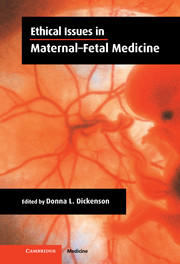Book contents
- Frontmatter
- Contents
- List of contributors
- Acknowledgements
- 1 Introduction: recent debates in maternal–fetal medicine – what are the ethical questions?
- 2 Overview: a framework for reproductive ethics
- I GENERIC ISSUES IN PREGNANCY
- II INCEPTION OF PREGNANCY: NEW REPRODUCTIVE TECHNOLOGIES
- III FIRST AND SECOND TRIMESTER
- 12 Ethical and social aspects of evaluating fetal screening
- 13 Prenatal counselling and images of disability
- 14 Models of motherhood in the abortion debate: self-sacrifice versus self-defence
- 15 Who owns embryonic and fetal tissue?
- 16 The fewer the better? Ethical issues in multiple gestation
- IV THIRD TRIMESTER
- V NEONATAL LIFE
- Index
15 - Who owns embryonic and fetal tissue?
from III - FIRST AND SECOND TRIMESTER
Published online by Cambridge University Press: 29 September 2009
- Frontmatter
- Contents
- List of contributors
- Acknowledgements
- 1 Introduction: recent debates in maternal–fetal medicine – what are the ethical questions?
- 2 Overview: a framework for reproductive ethics
- I GENERIC ISSUES IN PREGNANCY
- II INCEPTION OF PREGNANCY: NEW REPRODUCTIVE TECHNOLOGIES
- III FIRST AND SECOND TRIMESTER
- 12 Ethical and social aspects of evaluating fetal screening
- 13 Prenatal counselling and images of disability
- 14 Models of motherhood in the abortion debate: self-sacrifice versus self-defence
- 15 Who owns embryonic and fetal tissue?
- 16 The fewer the better? Ethical issues in multiple gestation
- IV THIRD TRIMESTER
- V NEONATAL LIFE
- Index
Summary
Background: why does ownership of embryonic and fetal tissue matter?
Until very recently the question of who owns embryonic or fetal tissue was of limited commercial importance, although there were applications of aborted fetal tissue in the treatment of Parkinson's disease, diabetes mellitus and other conditions. With a few exceptions the use of embryonic tissue was, so to speak, a non-issue (Boer, 1994), although the use of ovarian fetal tissue was specifically forbidden by Parliament.
By mid-1999, however, commercial exploitation of stem cells had been termed the most controversial ethical issue in biomedicine (Capron, 1999). The threshold event occurred in November 1998, when two separate teams of US scientists claimed that they had managed to isolate human embryonic and fetal cells and grow them indefinitely under laboratory conditions. These pluripotent and/or totipotent cells are effectively the parent cells for all bodily tissues, with an unlimited capacity to divide and the theoretical potential to become any body tissue. (Some authors equate pluripotent and otipotent cells, but others distinguish between totipotent cells, at the 2–4 cell stage, which are capable of giving rise to every cell line in the body and to an entire human individual, and pluripotent cells, which are derived from the blastocyst at a slightly later stage of development, when the outer and internal cells have already become differentiated.)
- Type
- Chapter
- Information
- Ethical Issues in Maternal-Fetal Medicine , pp. 233 - 246Publisher: Cambridge University PressPrint publication year: 2002
- 2
- Cited by

